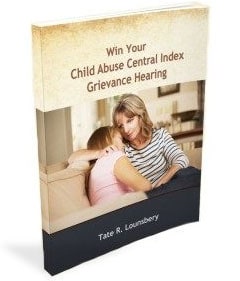What You Need to Know About the Humphries Lawsuit
The facts are quite clear—you don't deserve to have your name on the California Child Abuse Central Index (CACI), but it is.
However, getting your name removed from this list – that brands you as a child abuser for the rest of your life – is incredibly challenging.
That isn't to say it's impossible—our firm does have an approximately 90% success rate in removing clients' names from the list—but it will serve you well to understand the legal precedent involved in wiping your name from the database.
A case known as the Humphries lawsuit will clarify many legalities involved in removing your name from the CACI. Keep in mind that this story takes place before people had a right to have a CACI grievance hearing to get their names off the CACI.
The Story of Humphries Versus the County of Los AngelesBack in April 2001, Craig and Wendy Humphries were arrested on the single charge of felony torture under California Penal Code § 206.
It stemmed from when Craig's daughter, from a previous marriage, on the night of March 17, took the Humphries' car without their knowledge. She drove to her mother's home in Utah, before reporting that she'd been the victim of the Humphries' abuse for months on end.
The day after the arrest, Detective Charles Wilson (the arresting officer) identified the report as substantiated. As per state mandates, Craig and Wendy Humphries were identified as child abuse suspects with a "substantiated" report in the CACI.
Working to the Humphries' detriment was the emergency room physician, who diagnosed “non-accidental trauma, with extremity contusions.”
However, it was later found out that the trauma and contusions were the results of a surgically removed melanoma. The family doctor also saw no signs of abuse during follow-up appointments after the surgery.
These findings led to the criminal case being dismissed in August of 2001. Beyond that, the Humphries were ruled factually innocent of the felony torture charge, meaning the relevant arrest records were to be sealed and destroyed.
It's also worth noting that a Sheriff's deputy placed the Humphries' other two other children in protective custody after the arrest. He picked them both up from school without a warrant. Each child denied fearing abuse or mistreatment and wanted to return home. Instead, they were placed into foster care.
But Their Names Were Still on the CACIThe Humphries' name was cleared in the legal system, but they received a notice stating that if they wanted their name off the CACI, they should address their request to Detective Wilson.
In May of the next year, after contacting LASD's Family Crimes Bureau through their attorney, the Humphries discovered that Detective Wilson wasn't employed by the bureau anymore.
The LASD Sergeant then informed the Humphries' lawyer that after an independent investigation, the listing wouldn't be reversed. Despite the case's dismissal, it was believed that a crime must have occurred since charges were filed.
The Stigma-Plus TestThe Humphries had to sue LA County in order to get off the CACI.
Eventually, a court ruled that the Los Angeles County violated the Fourteenth Amendment by erroneously placing Craig and Wendy on the CACI and failing to give them an opportunity to dispute the listing.
In order to get to that ruling, the court had to evaluate whether the Humphries’ constitutional rights had been violated due to the stigma of being labelled a child abuser and placed on the CACI.
(For the rest of this article, we’ll review a Comment in an academic journal: Shaudee Navid, “They’re Making a List, but Are They Checking It Twice? How Erroneous Placement on Child Offender Databases Offends Procedural Due Process” UC Davis Law Rev. Vol 44:1641.)
When courts decide whether a person’s constitutional rights have been violated, the courts apply a “stigma-plus test.”
In Wisconsin v. Constantineau, the United States Supreme Court held that a constitutionally protected liberty interest may be implicated “where a person's good name, reputation, honor, or integrity is at stake because of what the government is doing to him.” 400 U.S. 433, 437, (1971). In Paul v. Davis, the Supreme Court clarified that procedural due process protections apply to reputational harm only when a plaintiff suffers stigma from governmental action plus alteration or extinguishment of “a right or status previously recognized by state law.” 424 U.S. 693, 711, (1976). This holding has come to be known as the "stigma-plus test." See Hart v. Parks, 450 F.3d 1059, 1070 (9th Cir.2006).
Satisfying the Stigma-Plus Test Criteria at the Federal LevelThe federal court ultimately ruled that LA County could be blamed for defaming the Humphries and stigmatizing them via the erroneous CACI listing.
A contributing factor to this finding is that both Humphries could not be licensed childcare professionals. Nor were they allowed to work as peace officers.
Wendy was once a teacher and was no longer permitted to even volunteer at schools, never mind renewing her teaching credentials.
Furthermore, California was deemed to be in violation of the Fourteenth Amendment due to the lack of CACI removal procedures. It was decided that a vital liberty interest of the Humphries was at stake since the government's action impeded their legal rights.
It was then determined that the risk of erroneous deprivation of their rights was high, due to the CACI system's presumption of guilt unless the reporting investigators retracted their findings. The federal court saw this as an inadequate procedural safeguard that flew in the face of the Humphries' due process rights.
A CACI Listing Doesn't Have to Be a Permanent MarkIt's horrifying to think that even after your innocence is proven, and deemed as such by the courts, your name can still be in the CACI.
Fortunately, there's precedent showing that your name can be removed if you follow the necessary steps.
 Lounsbery Law Office, PC Home
Lounsbery Law Office, PC Home
